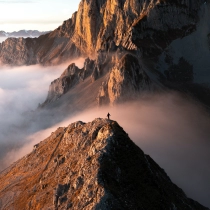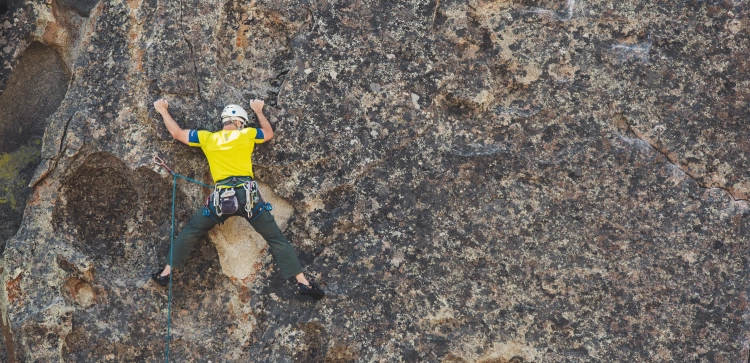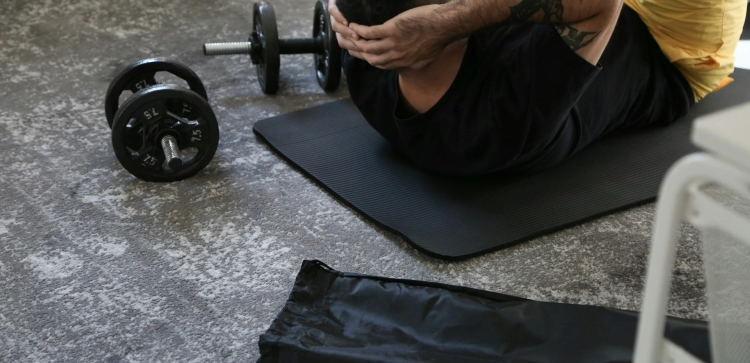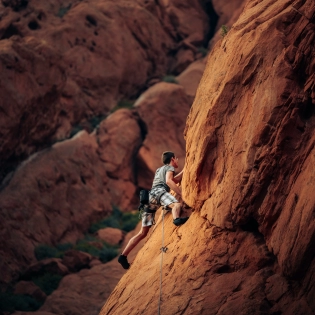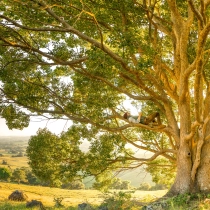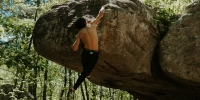Bouldering For Beginners: A Step-by-Step Approach To Getting Started

Welcome to the captivating world of bouldering – a dynamic and increasingly popular form of climbing that combines physical prowess with intricate problem-solving. Often described as a vertical puzzle, bouldering offers unparalleled satisfaction upon conquering a challenging "problem." This guide will take you from understanding the core concept of bouldering to optimizing your training sessions, mastering progression strategies, and discovering why climbers keep coming back to this addictive sport.
- What Is Bouldering? Understanding The Concept In Climbing
- Cracking The Code: Understanding Bouldering Problems And Routes
- What Are Bouldering Problems?
- Route Setting And Grading Systems:
- Reading Bouldering Problems (Beta):
- Strategies For Improving Problem-Solving Skills:
- Bouldering For Beginners: A Step-by-Step Approach To Getting Started
- 1. Find Your Location:
- 2. Gear Up: Essential Equipment For Beginners
- 3. Master Basic Techniques: The Foundation Of Good Climbing
- 4. Warm-Up And Cool-Down: Preventing Injuries
- 5. Common Beginner Mistakes To Avoid:
- Bouldering Frequency And Duration: Optimizing Your Sessions For Progress
- Optimal Session Frequency:
- Optimal Session Duration:
- Importance Of Rest And Recovery:
- Avoiding Overtraining:
- Progression Strategies For Beginners In Bouldering
- 1. Master The Basics (and Keep Refining Them!):
- 2. Regular And Consistent Climbing:
- 3. Set Achievable Goals:
- 4. Vary Your Routes And Styles:
- 5. Focus On Specific Strength Development:
- 6. Rest And Recover Intelligently:
- 7. Climb With Others:
- The Addictive World Of Bouldering: Why Climbers Keep Coming Back
- The Thrill Of Problem Solving:
- Continuous Physical And Mental Engagement:
- Accessibility And Community:
- The Drive For Progression:
- Conclusion
- FAQ: Your Common Bouldering Questions Answered
- What Is Bouldering?
- Do Beginners Need Special Gear For Bouldering?
- How Often Should Beginners Go Bouldering?
- How Long Should A Bouldering Session Last?
- What Is A "bouldering Problem"?
- How Are Bouldering Problems Graded?
- How Can Beginners Progress In Bouldering?
- Is It Possible To Progress In Bouldering Without Any Prior Climbing Experience?
- What Are Some Common Bouldering Injuries And How Can I Prevent Them?
- How Important Is Technique Versus Strength In Bouldering?
- What Is "beta" In Bouldering?
- What Is The Ideal Duration For A Bouldering Warm-up?
- Why Do Climbers Find Bouldering So Addictive?
What is Bouldering? Understanding the Concept in Climbing
Bouldering is a unique and accessible style of rock climbing that focuses on scaling shorter rock formations, known as "boulders," or low-height walls, typically no more than 15-20 feet high. Unlike traditional roped climbing disciplines, bouldering emphasizes powerful, technical movements and problem-solving over sustained endurance at great heights.
Core Principles and Safety:
-
No Ropes or Harnesses: The defining characteristic of bouldering is the absence of ropes or harnesses. This allows for a sense of freedom and immediacy in movement.
-
Safety Measures: Safety in bouldering relies primarily on two key elements:
-
Crash Pads: Thick foam mats placed on the ground below the climbing area to cushion falls.
-
Spotters: Individuals (typically other climbers) who stand below the climber to guide falls, ensuring the climber lands safely on the crash pad, often by helping to direct their momentum.
-
-
Emphasis: Bouldering prioritizes power, technique, and creative problem-solving skills over sustained vertical ascent. It challenges climbers to navigate various holds, ranging from positive "jugs" to challenging "slopers" and tiny "crimps."
History and Evolution:
Originally, bouldering served as a training method for longer, more dangerous climbs, allowing climbers to practice difficult moves closer to the ground. Over time, it evolved into a distinct and celebrated discipline, appreciated for its intense physical and mental demands. The rise of indoor bouldering gyms has significantly increased its accessibility, providing a controlled environment to learn and practice.
Cracking the Code: Understanding Bouldering Problems and Routes
In bouldering, climbing routes are uniquely referred to as "problems." This terminology perfectly captures the essence of the sport: each route is a physical and mental puzzle that climbers must solve by understanding how to climb it efficiently and effectively. This involves a deep understanding of hold types, grip techniques, precise body positioning, efficient energy conservation, and sometimes explosive, dynamic movements.
What are Bouldering Problems?
A "problem" refers to a specific sequence of moves on a boulder or climbing wall, typically marked by a set of colored holds leading from a designated start to a finishing hold. The challenge lies not just in executing the moves, but in deciphering the optimal sequence.
Route Setting and Grading Systems:
-
Route Setting: Dedicated route setters design bouldering problems to challenge climbers in various ways, incorporating different hold types, angles, and movement styles. They aim to create engaging and thought-provoking sequences.
-
Grading Systems: The difficulty of bouldering problems is measured using specific grading scales. The most common in North America is the Vermin Scale (V-scale), ranging from V0 (easiest) to V17 (currently the hardest). The Fontainebleau (Font) scale is also widely used, particularly in Europe. Both scales are open-ended, meaning new, harder problems can always extend the top end of the scale. These grades provide a general indication of difficulty, allowing climbers to track their progression and choose appropriate challenges.
Reading Bouldering Problems (Beta):
Before even touching the holds, it's crucial to "read" the problem, a process also known as figuring out the "beta." This involves planning your approach by considering:
-
Start and End: Clearly identify the designated starting holds and the final top-out or finishing hold(s).
-
Hold Types and Grips: Assess each hold along the route. Is it a crimp, a sloper, a pinch, a jug? How will you best grip it?
-
Sequences and Transitions: Visualize the entire sequence of movements, paying close attention to the transitions between holds. How will you move your body from one position to the next? Break down the problem into smaller, manageable sections.
-
Body Positioning and Movement: Consider where your feet will go, how your hips will move, and whether the move requires static control or dynamic momentum. Efficient movement patterns are essential for conserving energy.
Strategies for Improving Problem-Solving Skills:
-
Plan Thoroughly: Before climbing, thoroughly plan your route. Even during warm-up climbs on easier problems, practice meticulously planning and sticking to your envisioned sequence.
-
Experiment and Adapt: If you get stuck on a problem, don't be afraid to try different sequences. Seek insights from other climbers ("beta"), and consider alternative solutions. The beauty of bouldering is the multitude of ways a problem can be solved.
-
Chalk as a Memory Aid: While primarily used for grip, chalk marks can serve as subtle cues left by previous climbers, indicating crucial footholds or hand positions. However, remember to explore your unique approach; what works for one climber may not be optimal for another.
-
Set Smaller Goals: On challenging climbs, setting smaller, achievable goals (e.g., reaching a specific hold, completing a sequence) can help maintain motivation and build confidence.
Bouldering for Beginners: A Step-by-Step Approach to Getting Started
Bouldering is a fantastic entry point into the world of climbing due to its minimal equipment requirements and the immediate sense of achievement it offers. Here's a step-by-step approach to help you get started safely and effectively:
1. Find Your Location:
-
Bouldering Gyms: For beginners, an indoor bouldering gym is the ideal starting point. They offer a controlled environment, varied problems, safety mats, and experienced staff who can provide guidance.
-
Outdoor Spots: While outdoor bouldering is exhilarating, it's best to gain experience in a gym first. When venturing outdoors, go with experienced climbers who can teach you about local ethics, spotting techniques, and appropriate crash pad placement.
2. Gear Up: Essential Equipment for Beginners
One of the appeals of bouldering is the minimal equipment needed. For indoor bouldering, you primarily need:
-
Climbing Shoes: Specifically designed for grip and precision on small holds. Gyms typically offer rentals.
-
Chalk Bag: Contains chalk (magnesium carbonate) to keep your hands dry and improve grip.
-
Comfortable Clothing: Loose, flexible clothing that allows for a full range of motion.
For outdoor bouldering, you'll also need:
-
Crash Pad: Essential for cushioning falls.
-
Climbing Brush: Used to clean excess chalk and rubber off holds, improving friction for subsequent attempts.
3. Master Basic Techniques: The Foundation of Good Climbing
Focus on these fundamental techniques from day one:
-
Footwork: This is arguably the most important aspect of climbing. Learn to place your feet precisely and lightly on footholds, using the sticky rubber of your shoes for maximum friction. Drive through your legs to push yourself upwards, rather than solely pulling with your arms.
-
Handholds and Grip: Understand the different types of holds (jugs, crimps, slopers, pinches) and how to grip them efficiently to conserve energy and reduce strain.
-
Body Positioning and Movement: Learn to keep your hips close to the wall, use flagging (extending a leg for balance), and move fluidly. Effective body positioning conserves energy and allows you to reach distant holds.
4. Warm-Up and Cool-Down: Preventing Injuries
Proper warm-up and cool-down routines are critical for preventing injuries and improving performance.
-
Warm-Up: Before each session, perform 10-15 minutes of light cardio (e.g., jumping jacks, jogging) followed by dynamic stretches (arm circles, leg swings, torso twists) to increase blood flow and prepare your muscles and joints for movement. Finish with some easy climbing on very low-grade problems.
-
Cool-Down: After your session, engage in static stretching, holding each stretch for 20-30 seconds, to improve flexibility and aid in muscle recovery. Focus on forearms, shoulders, back, and hips.
5. Common Beginner Mistakes to Avoid:
-
Over-reliance on Arms: A common pitfall. Remember to push with your legs!
-
Skipping Warm-ups/Cool-downs: This significantly increases injury risk.
-
Ignoring Technique: Prioritize learning efficient movement patterns over brute force.
-
Overtraining: Allow adequate rest for recovery and adaptation.
-
Climbing Only Hard Problems: Mix in easier problems to refine technique and build endurance.
Bouldering Frequency and Duration: Optimizing Your Sessions for Progress
Finding the optimal bouldering frequency and duration is crucial for sustained progress, effective muscle adaptation, and preventing overexertion, especially for beginner and intermediate climbers. The key is to listen to your body's signals and find a balance between training stimulus and adequate recovery.
Optimal Session Frequency:
For novices and those relatively new to bouldering, it is generally recommended to start with 2-3 sessions per week. This frequency allows your body sufficient time to adapt to the new demands, recover from microtraumas, and build strength without leading to excessive fatigue or injury.
-
Initial Adaptation: Your muscles, tendons, and ligaments need time to strengthen and adapt to the unique stresses of climbing. Starting gradually prevents overuse injuries like tendonitis and strains.
-
Progressive Increase: As your body becomes accustomed to bouldering and your strength and technique improve, you can gradually increase your frequency. More experienced climbers might train 3-4 times a week, but always with attention to recovery.
Optimal Session Duration:
The duration of your bouldering sessions should be adjusted based on the intensity and your overall fitness, but a typical effective session for beginners generally lasts between 1 to 2 hours.
-
Warm-Up (15-20 minutes): This is non-negotiable. It includes light cardio and dynamic stretching, followed by very easy climbing to prepare your body.
-
Main Climbing (60-90 minutes): This is where the bulk of your climbing and problem-solving occurs. For high-intensity bouldering (focusing on power or limit sends), sessions might be shorter with more rest between attempts. For technique or endurance focus, the duration might be longer with less intense problems.
-
Cool-Down (10-15 minutes): Static stretching is vital for flexibility and recovery.
Importance of Rest and Recovery:
Rest days are as critical as climbing days for progress. Muscle growth and adaptation primarily occur during recovery.
-
Muscle Repair: Intense climbing creates microscopic tears in muscle fibers. Rest allows these tears to repair and rebuild stronger.
-
Energy Replenishment: Rest days replenish glycogen stores, essential for sustained energy during climbing.
-
Injury Prevention: Overtraining is a leading cause of climbing injuries, especially in fingers, elbows, and shoulders. Adequate rest allows connective tissues to recover.
-
Listen to Your Body: Pay attention to signs of fatigue, persistent pain, or decreased performance. These are clear signals that your body needs more rest. If you feel tired or weak, it's better to take an extra rest day than to push through, which can lead to injury or deeper fatigue.
Avoiding Overtraining:
Overtraining happens when your body doesn't get enough recovery time between intense sessions, leading to a plateau or even a decline in performance, increased injury risk, and general fatigue.
-
Symptoms: Persistent fatigue, decreased performance, prolonged muscle soreness, sleep disturbances, irritability, increased susceptibility to illness.
-
Prevention: Adhere to recommended frequencies, ensure proper nutrition and hydration, prioritize sleep, and incorporate active recovery (light activities like walking, yoga) on rest days. Varying the intensity and focus of your sessions also helps prevent overtraining specific muscle groups.
Progression Strategies for Beginners in Bouldering
Once you've grasped the basics, the exciting journey of progression begins. For beginners, a structured approach is key to moving beyond the initial grades (V0-V2) and building a solid foundation for more advanced climbing. Remember that consistent dedication, practice, and a willingness to learn are essential to achieving your climbing goals.
1. Master the Basics (and Keep Refining Them!):
While you might be eager to tackle harder problems, continuously refining your foundational skills on easier routes (V0-V2, gradually moving to V3-4 as you progress) is paramount. This includes:
-
Technique First: Prioritize efficient movement over brute strength. Focus on precise foot placements, engaging your core, and using your legs to push. Efficient movement patterns conserve energy and reduce strain.
-
Footwork Drills: Practice silent feet, smearing, edging, and finding optimal foot positions.
-
Body Positioning: Experiment with flagging, drop-knees, and hip rotation to maintain balance and reach.
2. Regular and Consistent Climbing:
Aim for at least two to three bouldering sessions per week. This consistency helps your muscles adapt, improves strength, and enhances technique more effectively than sporadic, intense sessions. Your body and strength will adapt to the sport as you progress, and you will naturally get stronger just by climbing.
3. Set Achievable Goals:
Define clear, realistic goals to maintain motivation and track progress. This could be:
- Sending a specific V-grade problem.
- Mastering a new technique (e.g., a heel hook).
- Completing a problem more efficiently or with better control.
- Developing specific strengths (e.g., holding a hangboard position for longer).
4. Vary Your Routes and Styles:
Don't stick to problems that only play to your strengths. Actively seek out:
-
Diverse Angles: Climb on slabs, verticals, slight overhangs, and steep overhangs.
-
Different Hold Types: Practice on crimps, slopers, pinches, volumes, and jugs.
-
Varying Movement Styles: Work on dynamic moves, static moves, balance-intensive problems, and powerful sequences. This comprehensive approach builds a well-rounded skill set.
5. Focus on Specific Strength Development:
While climbing builds overall strength, targeted training can accelerate progress for beginners:
-
Finger Strength: For beginners, simply climbing regularly will build finger strength. As you advance, consider hangboard training, but avoid it until your tendons are conditioned.
-
Core Strength: Incorporate specific core exercises (planks, leg raises, Russian twists) to enhance body tension and stability.
-
Antagonist Muscles: Balance your climbing-specific muscles (pulling) by strengthening antagonist muscles (pushing) like chest and triceps to prevent imbalances and injuries.
6. Rest and Recover Intelligently:
As discussed in the frequency section, rest days are crucial. Ensure proper nutrition, hydration, and sleep to support muscle repair and growth.
7. Climb with Others:
-
Learning and Beta: Climbing with more experienced individuals provides invaluable learning opportunities and "beta" (information about solving a problem).
-
Motivation and Camaraderie: The supportive bouldering community fosters camaraderie, motivation, and a shared passion. Discussing problems and cheering each other on enhances the experience.
The Addictive World of Bouldering: Why Climbers Keep Coming Back
Bouldering is more than just a sport; for many, it becomes a deeply engaging and even addictive passion. Its growing popularity stems from a unique blend of physical challenge, mental stimulation, and social connection that keeps climbers eagerly returning to the wall.
The Thrill of Problem Solving:
-
Vertical Puzzles: Bouldering is fundamentally about solving intricate physical puzzles. Each "problem" presents a unique sequence of moves that requires creativity, analysis, and strategic thinking to unlock.
-
Unparalleled Satisfaction: The moment of "sending" a problem—successfully completing a challenging sequence—provides an unparalleled sense of accomplishment and satisfaction. It's a highly rewarding experience that fuels the desire to tackle the next, even harder, challenge.
Continuous Physical and Mental Engagement:
-
Holistic Workout: Bouldering offers a full-body workout that sculpts lean muscle, improves strength, enhances flexibility, and boosts cardiovascular fitness. The visible physical transformation is a strong motivator.
-
Meditative Focus: The intense concentration required during a climb can lead to a "flow state," where climbers are fully immersed in the present moment, forgetting everyday stresses and distractions. This meditative aspect provides a powerful mental escape and a sense of calm.
-
Sense of Achievement: Each successfully completed problem, no matter how small, reinforces a sense of personal achievement and continuous improvement, which is incredibly motivating.
Accessibility and Community:
-
Minimal Gear: The relatively low barrier to entry in terms of equipment (primarily shoes and chalk) makes it easy for newcomers to try.
-
Indoor Gyms: The proliferation of indoor bouldering gyms has made the sport highly accessible, regardless of weather or proximity to outdoor rock.
-
Welcoming Community: The bouldering community is renowned for being welcoming, supportive, and collaborative. Climbers often share beta, cheer each other on, and form strong bonds, fostering a sense of belonging and camaraderie that makes coming back even more appealing.
The Drive for Progression:
-
Goal-Oriented: The clear grading system provides tangible goals for climbers to strive for, fueling a desire to improve and conquer harder problems.
-
Training Becomes Routine: For dedicated boulderers, training programs and refining skills become an enjoyable part of their daily routine as they strive to reach new skill levels and experience the continuous sense of achievement that fuels their passion.
-
"Just One More Try": The inherent challenge and the immediate feedback of success or failure on a problem often lead to the "just one more try" mentality, pulling climbers back to the wall again and again.
Conclusion
Bouldering is far more than just a physical exercise; it's a profound engagement with challenge, a journey of continuous self-improvement, and a gateway to a vibrant, supportive community. From understanding its fundamental concepts and deciphering complex problems to optimizing your training and embracing progression strategies, this guide provides a definitive roadmap to unlocking your potential. Whether you're drawn by the thrill of solving a vertical puzzle, the pursuit of functional strength, or the camaraderie of fellow climbers, the addictive world of bouldering promises endless opportunities for growth, satisfaction, and exhilaration. Embrace the process, listen to your body, and enjoy the transformative power of the climb.
FAQ: Your Common Bouldering Questions Answered
What is bouldering?
Bouldering is a style of rock climbing that involves scaling shorter rock formations or low-height walls (typically under 20 feet) without the use of ropes or harnesses. Safety is maintained through crash pads on the ground and spotters. It emphasizes power, technique, and problem-solving.
Do beginners need special gear for bouldering?
For indoor bouldering, essential gear includes climbing shoes (often rented at gyms) and a chalk bag. For outdoor bouldering, you'll also need a crash pad. Comfortable, flexible clothing is always recommended.
How often should beginners go bouldering?
For beginners, 2-3 sessions per week is generally recommended. This allows sufficient time for muscles, tendons, and ligaments to adapt and recover, preventing overtraining and injury while promoting consistent progress.
How long should a bouldering session last?
An optimal bouldering session typically lasts between 1 to 2 hours, including a 15-20 minute warm-up, 60-90 minutes of main climbing, and a 10-15 minute cool-down.
What is a "bouldering problem"?
A "bouldering problem" is the term for a specific route or sequence of moves on a boulder or climbing wall. Climbers must "solve" this problem using a combination of strength, technique, and strategic thinking from a designated start to a finish.
How are bouldering problems graded?
Bouldering problems are typically graded using the V-scale (V0 being easiest, V17 currently hardest) in North America, or the Fontainebleau (Font) scale (e.g., 3, 4, 5A, 5B, 5C, 6A, etc.) in Europe. These open-ended scales indicate the perceived difficulty.
How can beginners progress in bouldering?
Beginners should focus on mastering fundamental techniques (footwork, body positioning), consistent practice (2-3 times a week), setting achievable goals, varying routes and climbing styles, and incorporating targeted strength training and proper rest. Climbing with others can also accelerate learning.
Is it possible to progress in bouldering without any prior climbing experience?
Absolutely! Bouldering is an excellent starting point even without prior climbing or athletic experience. The sport itself naturally builds the required strength and technique as you consistently engage with it, starting with easier grades.
What are some common bouldering injuries and how can I prevent them?
Common bouldering injuries often include finger strains, pulley injuries, shoulder impingement, and elbow tendonitis (golfer's or tennis elbow). Prevention involves thorough warm-ups, proper technique (especially leg drive to reduce arm strain), listening to your body, adequate rest, and incorporating cross-training for balanced strength development.
How important is technique versus strength in bouldering?
For beginners, technique is often more important than raw strength. While strength is valuable, efficient movement, precise footwork, and good body positioning allow climbers to conserve energy and overcome physical limitations. As you progress, a balance of both becomes crucial.
What is "beta" in bouldering?
"Beta" refers to information or advice about how to climb a specific bouldering problem. This can include suggestions on hand and foot placements, body positions, specific moves, or sequences. Climbers often share beta to help each other solve problems.
What is the ideal duration for a bouldering warm-up?
A bouldering warm-up should typically last 15-20 minutes, including light cardio, dynamic stretches, and some easy climbing on very low-grade problems to gradually prepare your muscles and joints.
Why do climbers find bouldering so addictive?
Climbers find bouldering addictive due to the immense satisfaction of solving challenging physical puzzles, the continuous physical and mental engagement it provides, the welcoming community aspect, and the clear, motivating path of progression through its grading system.
